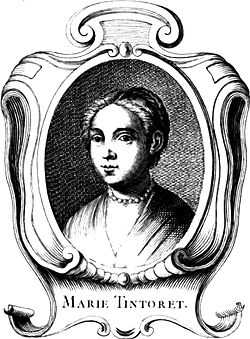Marietta Robusti

Marietta Robusti (1560? – 1590) was a female Venetian painter of the Renaissance period. She is one of very few known female artists of this period, a group that included Sofonisba Anguissola, Lucia Anguissola, Lavinia Fontana, and Diana Scultori Ghisi.
Biography
The only known primary source for details of Marietta Robusti’s life is Carlo Ridolfi’s Life of Tintoretto, first published in 1642, although she is mentioned briefly in Raffaelo Borghini’s Il Riposo della Pitura e della Scultura of 1584.[1] These two sources disagree on the year of her birth: according to Borghini, she was born in 1555,[1] but Carlo Ridolfi indicates that she was born in 1560.[2]
Marietta was born and died in Venice, the eldest daughter of the painter Jacopo Robusti, from whom she inherited her nickname, la Tintoretta (translated as "little dyer girl", after Jocopo’s father’s occupation as a tintore, or dyer). She is thus variously known as Marietta Robusti, Marietta Tintoretto, and la Tintoretta.
Since conventions of the time dictated that women remained in the privacy of the domestic sphere and were not welcome in the public world of art production and sale, Marietta and her female contemporaries gained access to the art world through their artist fathers or brothers.[3] Marietta's artistic training consisted of serving an apprenticeship in the collaborative environment of her father’s workshop, where she probably contributed to her father’s paintings with backgrounds and figure blocking, as was the usual distribution of labor in painting workshops of the time.[4]
Evidence suggests that Marietta received no commissions for major religious works such as altarpieces or other church decorations, and that she was mainly a portraitist.[5]
Ridolfi describes Marietta’s close relationship with her father at great length. Not only did she learn at his knee, as a child she also liked to dress like a boy so that she could go everywhere with Jacopo. Emperor Maximilian and King Philip II of Spain both expressed interest in hosting her as a court painter, but her father refused their invitations on her behalf because he couldn’t bear to part with her. In 1578 he arranged for her to marry a Venetian jeweler, Mario Augusta, to ensure she would always stay near him. Jacopo also had Marietta instructed in singing and playing the harpsichord, clavichord, and lute.
She died of unrecorded causes in 1590, and was buried in Santa Maria dell’Orto in Venice.
Attributions and assessment
The only painting that can be conclusively attributed to Marietta Robusti is her Self Portrait (c. 1580; Uffizi Gallery, Florence). This portrait depicts Marietta posed before a harpsichord, holding a musical text that has been identified as a madrigal by Philippe Verdelot, "Madonna per voi ardo". It has been postulated that the inclusion of this text, whose opening lines are "My Lady, I burn with love for you and you do not believe it", suggests that the painting was created for a male viewer, possibly Marietta's husband.[6]
Other attributions include: Old Man and a Boy (c. 1585; Kunsthistorisches Museum, Vienna); Portrait of Ottavio Strada (c. 1567-68; Stedelijk Museum, Amsterdam); and two small paintings of the Virgin and Child (dates unknown, Cleveland Museum of Art, Ohio). Portrait of Two Men (Gemäldegalerie Alte Meister, Dresden), signed "MR", is thought to be Marietta Robusti's only surviving signed work.[5]
Notes
- ↑ 1.0 1.1 Eric Newton, Tintoretto. (London: Longmans, Green and Co., 1952), 62.
- ↑ Carlo Ridolfi, Life of Tintoretto, trans. Catherine and Robert Enggass (University Park, PA: Pennsylvania State University Press, 1984), 99.
- ↑ H.T. Niceley, "A Door Ajar: The Professional Position of Women Artists," Art Education 45, no. 2 (Mar., 1992): 6-13.
- ↑ Newton, Tintoretto, 66.
- ↑ 5.0 5.1 Grove Art Online, s.v. “Marietta Robusti.” Available from Grove Art, George Mason University Lib.(accessed 10 February 2008).
- ↑ Katherine A. McIver, "Lavinia Fontana's 'Self-Portrait Making Music'," Women's Art Journal 19, no. 1 (Spring-Summer 1998): 3-8.
References
- McIver, Katherine A. "Lavinia Fontana's 'Self-Portrait Making Music'," Women's Art Journal 19, no. 1 (Spring-Summer 1998): 3-8.
- Newton, Eric. Tintoretto. London: Longmans, Green and Co., 1952.
- Niceley, H.T. "A Door Ajar: The Professional Position of Women Artists," Art Education 45, no. 2 (Mar., 1992): 6-13.
- Ridolfi, Carlo. The Life of Tintoretto and of his children Domenico and Marietta. Translated by Catherine Enggass and Robert Enggass. University Park, PA: Pennsylvania State University Press, 1984.
- Wasmer, Marc-Joachim. Die Künstlertochter Marietta Robusti, genannt Tintoretta, in: "Unser Kopf ist rund, damit das Denken die Richtung wechseln kann." Festschrift für Franz Zelger, ed. Matthias Wohlgemut, in collaboration with Marc Fehlmann, Zurich 2001, 463–494
External links
- Self Portrait at Scholars Resource (thumbnail)
- Portrait of Ottavio Strada at Web Gallery of Art
- Marietta Robusti in Dictionary of Painters and Engravers: Biographical and Critical by Michael Bryan
- Women Artists in History by Wendy Russ
- La Renaissance- WebMuseum, Paris by Nicolas Pioch